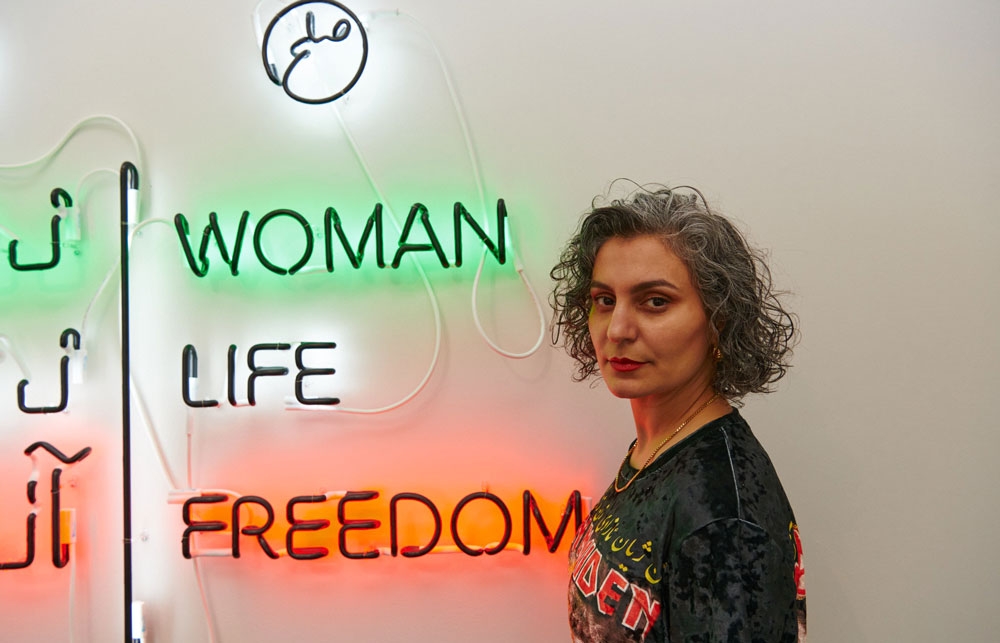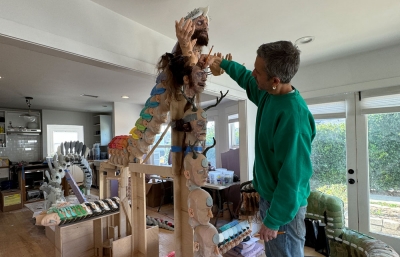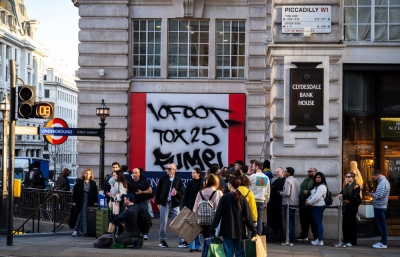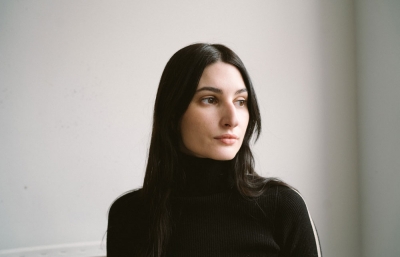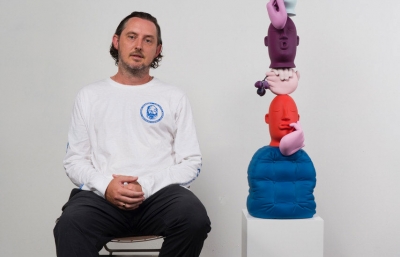Taravat Talepasand
Bold Blasphemy
Interview by Kristin Farr // Portrait by Joe Budd
Women Life Freedom is a movement amplifying the ongoing fight for the fundamental rights of Iranian women, who were mobilized when Mahsa Amini was arrested and brutalized for not wearing a hijab, and subsequently dying while in police custody. Iranian-American artist Taravat Talepasand, always a strong voice on behalf of global action, expresses powerful, provocative ideas about freedom.
When two female Muslim students complained of nightmares caused by Talepasand’s recent exhibition at a college art gallery in Minnesota, the school panicked—and ironically—veiled the windows in black curtains. “Absurd, considering I had this big neon piece that says Women Life Freedom, which is a statement against the veil,” the artist elaborated, describing this personal nightmare about being mistreated by an institution that had openly invited her work, only to backtrack, censor it, and wrongfully label it as violent.
Fortunately, this same exhibition was welcomed by the progressive Yerba Buena Center for the Arts in San Francisco, a city open to her conceptual artwork laced with LSD and hash oil.



Kristin Farr: How did it feel to see your exhibition at YBCA after the debacle in Minnesota?
Taravat Talepasand: It was a nice way of closing that unresolved gap, and celebrating with the community in San Francisco; former students I worked with at the San Francisco Art Institute, as well as the Iranian community. From the diaspora and adjacent countries in the Middle East, people really wanted to support it and be part of the conversation about what is happening in Iran, and the baseline of all my work. I’m a woman here in the United States finding connections between Eastern and Western cultures, and sometimes the similarities are blasphemous and taboo.
There were women at the show wearing hijabs, a good reminder that this protest isn’t about ripping the veil off women. It’s about the choice of how we want to present ourselves in the public realm, as much as it’s a choice for women to do what we want with our bodies. Again, there’s a similarity to these protests, women still continuing to fight for bodily autonomy and equality globally.
I created a space outside the main gallery where you see this video of a young girl dancing, this modest side of what it means to be a woman from Iran here in America; but when you go into the gallery, it’s all the work that’s been deemed inappropriate or questionable: nudity of women, the use of drugs as art materials, Trump’s Cheeto face on a rug…
Who’s the girl in the video?
That’s me, age ten, on Public Access TV in Portland, where there’s a very small Iranian community. I felt lost and marginalized growing up, but at that young age, I was trying to connect with my culture. There’s a Public Access show for Iranians on Friday nights at 9 pm, and I dreaded doing it. I begged my mom, “I don’t want to do this! What if my friends see it?” And she said, “Who’s gonna see this? No one is watching Public Access on a Friday night.” And then I thought, what if people can watch this at any time in the future?

Prescient!
I found it on YouTube in the early 2000s. As much as I was super embarrassed, I knew I would show it at some point. There’s a lot of controversial content in my work that might be triggering for some people, but I felt like the video was a nice reset. We all start from someplace! The way I danced to these songs! Some of them are older and cultural, and there’s one dance with a hat that’s traditionally for men! So it was my way of literally connecting with my inner child and showing that I have been a part of this culture for a long time, even though I was born in the United States.
Let’s talk about the denim jacket. Did you always show it hanging above the Trump rug?
It was in my 2017 exhibit at Guerrero Gallery, the jacket hanging from the noose, and I had the Peace in the Middle East neons behind it, which later became a chandelier at YBCA. A year later, I traveled to Iran. I made a Photoshop collage of a thousand images of Trump crying from Kim Kardashian’s Kimoji app, then brought the file to a factory in Iran that produces machine-made rugs and smuggled the rug back to the US. I actually displayed it with the jacket at YBCA in 2018. We still had Trump as president and I thought the combination worked—having this rebellious Iranian-American jacket, this weight on top of Trump’s crying face.
There were a lot of issues between Iran and America while Trump was president. Even though the jacket says Iran when you look at the patches, you see it’s really for a person who is outside of Iran. It’s punk rock, rebellious, like armor, and having patches of a Kimoji butt or a wet banana—things that have sexual connotations—really speaks to Iranians who are part of the diaspora, women who move freely with their bodies, who make choices for themselves and have the empowerment of being a woman outside of Iran.
But the double noose, hanging from the peace sign head, says a lot too because we’re still struggling. A lot of my work has layers, but that one especially. And it’s funny because the jacket lettering that says Iran Iran Iran came during the time of Kanye’s Saint Pablo album.

Oh yeah, his merch with that Old English font! Do you go through phases with these references and mediums, or does the content determine the materials?
A little bit of both. The use of hash oil was during the year cannabis was legalized in California. When you live in San Francisco, you always know somebody who can get illegal substances, so my friend showed me this butane hash oil he was making. It had a beautiful color, so I wondered if I could paint with it—and I couldn’t, because it’s super sticky. I tried to melt it, but what ended up working was ethanol! Grain alcohol dissolved the hash oil into a watercolor substance, but I couldn’t find enough because it’s illegal in California, so I had my mom buy and ship it to me from Oregon. The level of illegal substances I’m using is laughable.
Whenever I have an idea, I spend time on the research and find the best way to execute it, sometimes as a painting or drawing, neon or installation, or some unknown substance that no one has really used. I started working that way when I was studying and teaching at SFAI. Being very conceptual and finding meaning and allegory in everything I use is an important process in my practice.
Egg tempera seems like a significant material.
When I was a grad student, focusing on what it means to be Iranian and a woman coming from an Islamic regime, I found that egg tempera was used in Persian miniature painting at the same time as it was used in Europe, and it predates oil painting. I wanted to challenge myself. None of my professors used it or could talk about it, so I read a lot of books and I loved it. You’re using natural pigments, highly toxic as they are, with cobalts and cadmiums, and then egg yolk as the binder. It creates such a luminous surface that the colors are brighter than any other painting material, and it’s also got longevity. We can see that when we look at Flemish painting. There’s an eggshell kind of surface, so there’s no glare from any oil or the egg. You have to use just the right amount so that it doesn’t crack or flake off.
And what about porcelain?
Oh, the porcelain. When we think of porcelain, we think of Asian sculpture and Asian art history, which is very adjacent to Persian history. Using that material is very specific, so I wanted to make the connection to sculptures I’d see in museums and to the region and the world. It’s super smooth and soft, and when I created the molds, I didn’t know what to expect. It’s very white and matte, very pure, with almost this Mary Magdalene effect, with this spirituality; but when you really look closely at the sculpture, it’s absurd. The breasts are huge, almost Simpson-ized, but I’m talking about body modification.


I didn’t know plastic surgery was as prevalent in Iran as it is in the US until I saw your show.
There was a movement in Iran, the Green Movement, in 2009. That’s when women started to push back against the regime. It quickly fired up in protests and quickly ended, but then the rest of the Middle East picked up on it, and we had the Arab Spring, which kind of ended in Egypt.
Seeing so many young people going to the streets and fighting back against the political control in their countries was when I started feeling compelled to make work about female empowerment that I really did see in Iran and parts of the diaspora. I started researching and connecting with a lot of Iranian females who lived outside of Iran and were posing nude, sending me images of themselves, and giving me consent to share their stories and images. At the time, it was rare to see any Arab or burka imagery in pornography. I found this woman who was doing several different poses, and I wanted to make her into a sculpture, like a relic, or a modernized Venus of Willendorf.
A lot of women are choosing to cover their bodies, but also what is underneath, and how they dress and their appearances. I made a mold of the sculpture and produced many of them, some glazed, and some made into bronzes. It was around 2009-2012 when I created this Blasphemy series, sculptures, and drawings of the writer Roxana Shirazi, who wrote the book The Last Living Iranian Slut. She shared her sexual traumas in Iran in a Muslim household. I had never heard anyone speak about that outside of one-on-one conversations, but I got her consent to make images of her as part of the series.
The Blasphemy title explains it all. I’m not trying to hide behind the image. It really exists as one woman’s story and a collective female story as well. This work had been shown at Art Basel and other exhibits and fairs in the US and Europe. People understood the blasphemy connotation, but no one ever pushed back and said I shouldn’t be making it. Arab women would tell me they loved it, that it spoke to them. I got a lot of support until that exhibit in Minnesota. The Blasphemy drawings and sculptures were the pieces that the students had a huge objection to. They felt hurt. They had nightmares about it. But I thought about non-consensual viewing… How do you drive past the strip club billboards in Minnesota?

They’re everywhere. So, tell me more about how growing up in the ’80s and ’90s in Portland influenced you. Desert Storm happened during that time, and you have a painting named after that war.
Just that rebellious side of me, whether it’s the music or going beyond trends is what has stuck with me. How can I use or create something new for people to see or be a part of? I played piano for 11 years, and I was creative, but I was terrified of being an artist. I think I still kind of am!
I grew up in the suburbs and it was predominantly white, so you can imagine, in the ’80s, in the aftermath of the Iran hostage crisis, that it wasn’t cool to be from the Middle East. During the Iran-Iraq war, when the US sided with Iraq, my mom said to tell people I was from Iraq. And then we had the Desert Storm war and she said, “Don’t tell anybody you’re from the Middle East. Try not to talk about it.”
So that was a problem for me to try and figure out my identity and wanting to connect with Iranian culture. I masked myself in so many ways and didn’t accept the culture that I come from until I researched it on my own. So that’s why part of my practice is still discovering, negotiating, and renegotiating the parts of the culture that speak to me, as well as the parts that don’t.
It took me a long time to feel comfortable making images of a woman in a hijab or anything with a connection to Islam because I am opposed to it, and I feel privileged to be born in this country and be American. I want to use that power and privilege in my work as a woman. Sometimes I’ll consider making a soft turn away from work about female empowerment and being Iranian, but then the protests happen and here I am again!
It’s almost like I have no choice in making the work because I’m working through so much energy and trauma, as well as carrying the weight of other people's traumas whose stories I’m listening to. Making that connection is a real purpose in my practice.
Let’s talk about the White Devil piece.
There were US sanctions against Iran because it’s an effective way to apply pressure to a regime, but you’re actually applying pressure to the people. The regime could give zero fucks. They’re making money off it anyway, so when the sanctions are made, there is no value for Iranian currency. You can’t go to the bank here and make an exchange. It’s just paper. So, legally, I can paint or draw on it, burn it, whatever. I glued the currency together to make paper. In 2009, at my first exhibit in New York, I had stolen a bunch of those special ziplock bags used for liquids at airport security and put liquid LSD on Iranian currency. I’ve never tried LSD before—surprise, surprise! But I wore gloves and it was the most expensive material I’ve ever had to buy.
I had this idea of putting more value back into the currency than it would’ve had originally by putting drops of LSD on the watermark of Khomeini, and during the opening, I was giving it away in the ziplock bags. Some people were like, “What is this?” And others were like, “Are you fucking kidding me?” One person brought it to Dubai. It’s undetected when you go through security.
It was interesting that people would actually eat the money. They’d message me saying they totally peaked at the MoMA staring at Damien Hirst’s shark piece in the tank, and stuff like that.

That sounds awful.
Yeah! I don’t want to be tripping on that piece.
White Devil was a way for me to share that sanctions can do good, but also a lot of harm. The value of the money is nothing, so there’s an ongoing rise in inflation, and some people in Iran can’t afford food and rent. I wanted the currency to lend itself to that story, but also relate the parallels between Eastern and Western cultures with how drugs can infiltrate a certain group of people, although drugs are also a way to enlighten spiritually, to connect on another level.
Then I painted on top of the currency, this woman slaying the devil. In Iranian culture, there is a sacred book of Persian miniature paintings, the Shahnameh, which is The Book of Kings. One story is about the king slaying the white devil, another term for the West. I replaced the king with these Persian miniature paintings of women, giving them the power to do what the king did, or what men are known to do. So the piece has sanctions, currencies, and drug paraphernalia that are banned in both countries. It gives the power back to women, painted on top of an image of Mecca, which is Saudi Arabia, on one side, another strike on Islam in my more subtle way. Then you see Khomeini’s face - and he’s dosed with LSD.
Back to the Desert Storm painting. It’s not exactly a circle jerk…
Circle Jerks is one of my favorite bands. I own every vinyl of theirs. But the painting is a circle fuck, really.
The Persian miniature influence is strong in that one.
Those little figures are appropriated from an actual seventeenth-century miniature painting! I did not make that up. Every color and male body is exactly as you would see from the original, and that’s what’s so funny. I was painting the background and there was something very hot about that atmosphere. The color of the paint was called Persian rose, and I smudged it on top and it looked phallic, so I put it together with that reference from the miniature painting. I loved titling it Desert Storm because, yes, we lived through that, and it was a dreadful war when chemical warfare was elevated. I felt the painting had that kind of toxicity and heat of being in the desert. And then, boop! I put those guys in there. I love when people see it from afar, and then they come close and chuckle. No one is appalled, there’s just a sense of humor. They read the title and they get it.
TaravatTalepasand.com // This interview was originally published in the Juxtapoz FALL 2023 Quarterly // TARAVAT was on view at the YBCA in San Francisco this past summer

